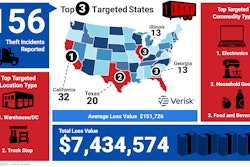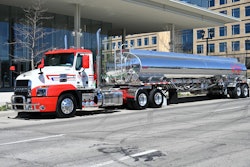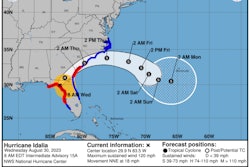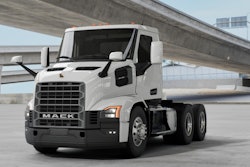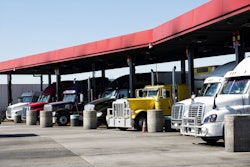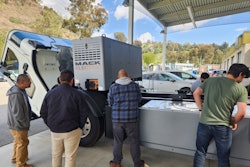New research conducted by the American Transportation Research Institute found that joining a state or national trucking association makes trucking companies safer than those that are both former members or were never members of associations.
Dan Murray, vice president of ATRI, joins Jason and Matt this week to talk about the findings of the study and what it means for motor carriers across the country.
Contents of this video
00:00 Trucking associations and safety
03:22 Trucking association members
05:56 Fatal crashes and vehicle violations
07:07 Proof of being safer
09:25 Reaching safety goals
11:31 Insurance companies and fleets
Jason Cannon:
This week's 10-44 is brought to you by Chevron Delo 600 ADF Ultra Low-Ash Diesel Engine Oil. It's time to kick some ash.
Matt Cole:
If fleets that join national or state trucking associations are safer than those that don't, do associations make carriers safer, or do safe carriers just tend to join associations?
Jason Cannon:
You're watching CCJ's 10-44, a weekly webisode that brings you the latest trucking industry news and updates from the editors of CCJ. Don't forget to subscribe and hit the bell for notifications so you'll never miss an installment of 10-44.
Hey everybody, welcome back. I'm Jason Cannon, and my co-host on the other side is Matt Cole. Trade associations in trucking provide fleets with a number of resources to its members. That includes training and education, research, advocacy, networking, and a lot more. Now, that's true at both the state and national association levels.
Matt Cole:
A new study conducted by the American Transportation Research Institute dove into the safety statistics of carriers who are members of state or national trade associations to determine if they're any safer than those who don't join, and if they are, is it because of the association or were they already generally a safer carrier? Dan Murray, Vice President of ATRI, joins us this week to talk about the findings of the study and what it means for the motor carriers across the country.
Dan Murray:
We always have one or two state trucking associations on our research advisory committee. And I believe it was Shawn Yadon, who at the time was the president of California Trucking Association, he raised this issue and was trying to get it submitted as a top industry issue through the RAC.
And just as background, we've discussed as an industry for years the idea that there might be a correlation between membership and safety. And not to pooh-pooh the concept, I've argued, "Well, the classic correlation does not imply causation" stuff. That comes out of research. And I said, "We probably could find a way to do the methodology, but at best it's a correlation. And we can't say that good safe companies don't seek out membership versus the membership making them safer."
So that was always a long-running dilemma. But we started talking and realized that if we'd add a second tier of analysis, which would give us the direction of a trend, current members, former members, never, then we could see the trend line and attribute the change in the trend, from active to not, as causation.
And everyone said, "Well, that's awesome." I think Shawn realized that the large RAC composed of motor carriers, vendors, federal, state, government, law enforcement, academia, would probably not vote it to the top. And so it was proposed by somebody, and off the top of my head, I don't remember, that we could use existing contributions that are made to ATRI by the state trucking associations. Almost everyone makes some contribution. We could use that to fund it. And so we asked the RAC, as an approval process, if that would meet their needs, and everyone said yes. So we did proceed with it. It was funded separately by the state trucking associations, and then we continued on with the RAC voting and came up with a separate five. That's the process that got us there.
Jason Cannon:
To compile the data needed for the study ATRI picked two state trucking associations from each of the four regions as well as the American Trucking Associations to provide lists of trucking companies that are current members and those that are former members. This allowed them to determine the companies that were never members of the associations.
Dan Murray:
So what we did is we took the existing TAEC regions. The TAEC is the 50 state trucking associations together. Believe it or not, they have their own trucking association executive council. We came up with a reasonable list of both geographically representative, as in a couple associations from each of the four regions, TAEC regions. Plus within those regions, we picked a small association and a large association, or I should say smaller and larger.
And then we also approached ATA to see if they wanted to participate. We ran the analysis. We obviously did a lot of data cleansing to make sure that we had adequate data and that the carrier lists were representative across. We wanted to make sure we were mapping apples to apples in terms of current, former, never.
Matt Cole:
Across various statistical analyses. ATRI found it to be true across the board that association member carriers had fewer crashers and violations than both former members and never members. We'll hear more on that from Dan after a word from 10-44 sponsor Chevron Lubricants.
Jason Cannon:
Protecting your diesel engine and its aftertreatment system has traditionally been a double-edged sword. The same engine oil that is so essential to protecting your engine's internal parts is also responsible for 90% of the ash that is clogging up your DPF and upping your fuel and maintenance costs. Outdated industry thinking still sees a trade-off between engine and emission system protection, and Chevron was tired of it. So they spent a decade of R & D developing a no-compromise formulation. Chevron Lubricants developed a new ultra low ash diesel engine oil that is specifically designed to combat DPF ash clogging. Delo 600 ADF with OmniMax technology cuts sulfate ash by a whopping 60%, which reduces the rate of DPF clogging and extends DPF service life by two and a half times.
And just think what you can do with all the MPGs you're going to add from cutting your number of regions. But Delo 600 ADF isn't just about after-treatment. It provides complete protection, extending drain intervals by preventing oil breakdown. Before you had to choose between protecting your engine or your after-treatment system, and now you don't. 600 ADF from Delo with OmniMax technology: it's time to kick some ash.
Dan Murray:
None of the truck-involved fatality crashes showed up as significant. And that's mostly because they're so rare it was nearly impossible to find a sample size large enough across three disparate groups that had enough fatal crashes to run the analysis relationships. So fatal crashes generally were not significant, but all crashes and all violations and certain driver violations, certain vehicle violations showed up in some cases way beyond the 99% confidence level. And the trend line held up. The safest folks out there in terms of crashes and violations were current members. Next safest was former. And least safe within those groups, I'm not saying they're not safe, but within those three groups, least safe were the never members.
And the trend line, again, was always from current to never, giving us that causation effect. So we can now say with certainty not to say that safe carriers don't join associations, but when they join, they become safer. And that's the key. That's the causation we were looking for in the research, the data.
Jason Cannon:
Dan says that now having data available that proves being in a state or national trucking association makes a carrier safer, that information could potentially be used by regulators and enforcement agencies for enforcement targeting.
Dan Murray:
Well, we weren't going to go too far out on a limb by telling insurance companies and enforcement agencies and regulatory agencies exactly what to do. But it's always safe to say that when you have limited resources and you're focused on any strategic outcome, even beyond safety, that you want to leverage the dollars, you want to leverage the resources to focus on the low-hanging fruit.
So if we know on that continuum that current members are the safest among the group, then it's relatively bold but it may argue that we should focus on the least safe folks, which in this instance is the never members. It's not up to ATRI to advocate for that, but that is a pretty rational argument. And I'd go so far as to say we also intimate that other associations could conduct similar research. We gave the methodology away. There's a lot of outcomes, even outcomes beyond safety, if the data is available, to look at per capita revenue for identical products and services, ROIs, even organizational sizes by membership.
So there's other non-safety metrics that associations outside of the trucking industry could easily run if they can obtain the metrics that they need. And I think they can. There's a lot of non-safety. Almost any industry could go look at OSHA-filed work injuries, which is safety again. But I'm sort of eager to have other industries, other association groups test the methodology to see. And it's conceivable that some associations, some industries are not as proactive in their association membership resources. But I would think any association that aggressively provides support to its members in the form of training, education, product services, I suspect they would see similar trend lines between the current, former, nevers.
Matt Cole:
Carriers that join associations deserve some credit, Dan says, because they're likely more committed to safety to begin with. The associations then provide additional resources to help those carriers reach their safety goals.
Dan Murray:
Well, to the credit of the motor carriers, I do think a carrier that joins an association is more open-minded, more committed, more innovative. I think there's attributes to carriers who join the associations that recognize that they need to look outside of their own organization if they're really going to maximize and leverage things like safety and ROIs and efficiency. So I think they're starting from a base that says, "We're innovative, open-minded, and looking for support." But then you get to the association effect. And I think it's associations that provide very, very solid resources.
And it is a quid pro quo. It's not just enough to provide a litany of products and services, training, safety councils. We think many of these have very active, even aggressive safety councils, but it has to be a carrier or a member who is going to leverage those resources. So it is a quid pro quo. It's not just on the association side. It's just not the motor carrier member, but the relationships that exist between those. And the peer exchange. We've done research and even cited it in this report, going back a ways, that says peer exchanges of information and experiences is the single most powerful resource out there for carriers.
When we looked at safety culture under a previous Transportation Research Board study, vendor marketing materials? Not anywhere near the top. But if I could call up my friendly competitor and say, "Hey, I know you're doing the following training, I know you bought the following safety systems. Can you tell me how they worked?" that became a powerful resource. And associations are phenomenal at developing peer exchange forums, and I think that's going to be a big piece of this.
Jason Cannon:
The results of the study could have an impact on insurance companies and how they view fleets too.
Dan Murray:
Well, to start with the insurance industry, they have struggled to be profitable for the last five or six years. In fact, based on anecdotal data, they just hit a year of profitability two years ago for the first time in almost a decade. So they're always looking for resources and guidance in terms of where do they put their actuarial formulas and how do they design them so that they're conservative in terms of raising premiums with the safe guys and much more liberal in terms of raising premiums with the marginal folks. So this becomes, again, an important tool for the insurance industry who's constantly looking for new ways of assessing safety performance. So I think this is important.
Now, that's our internal hypothesis. When you look at the number of report requests that have come in, close to 60% of all report requests for this research have come from insurance companies, which supports this concept that this could be a new tool from. And it's to date with all of the nuclear verdicts and less than perfect actuarial formulas. No matter who you are on the continuum of safety, you're getting insurance increases. The good guys might only get 10, 12% increases. The marginal carriers might get 30, 40%. But now the guys who are doing the right things, including buying technology and joining associations, now maybe they won't have to share the pain as much as they have with the marginal carrier.
Jason Cannon:
That's it for this week's 10-44. You can read more on ccjdigital.com. While you're there, sign up for our newsletter and stay up to date on the latest in trucking industry news and trends. If you have any questions or feedback, please let us know in the comments below. Don't forget to subscribe and hit the bell for notifications so you can catch us again next week.

